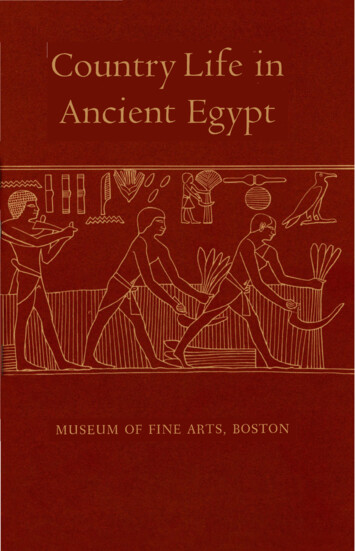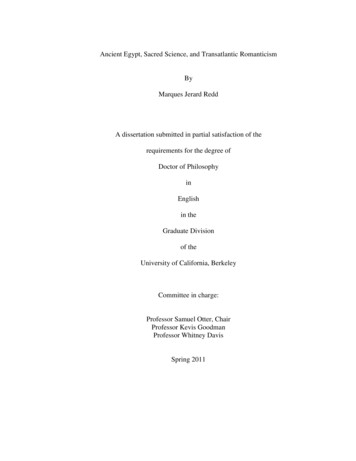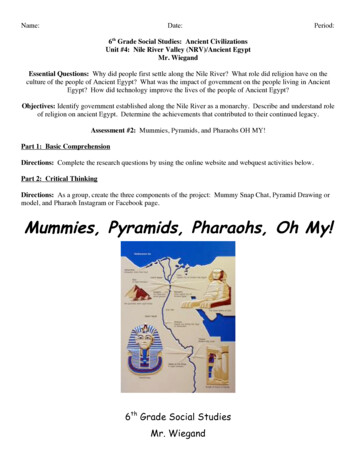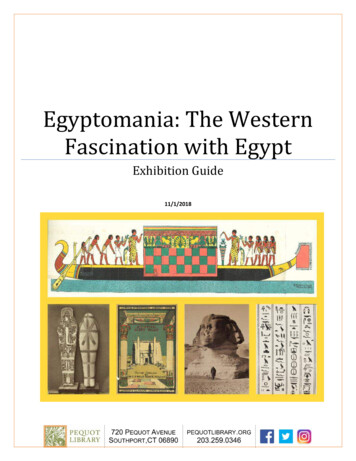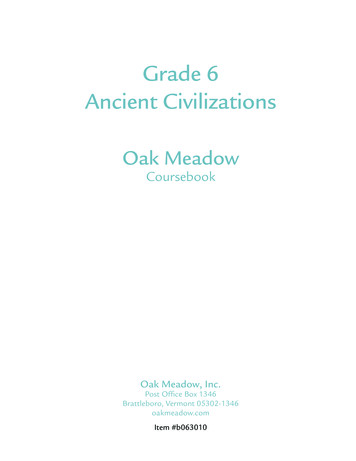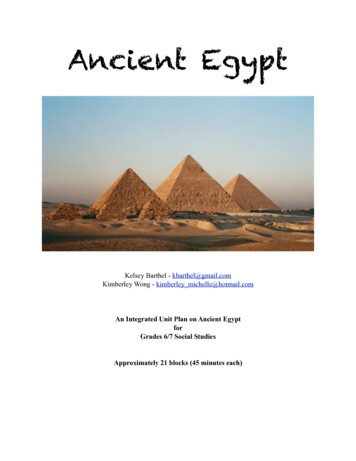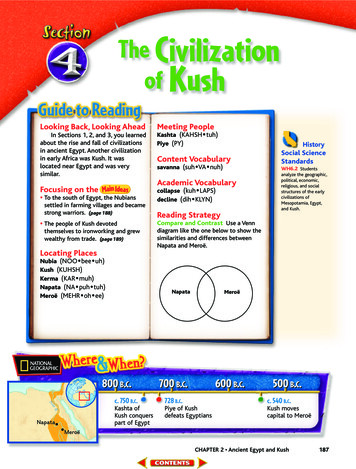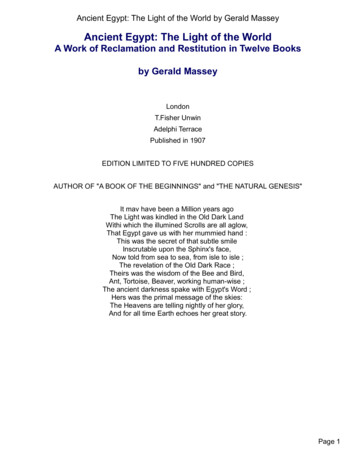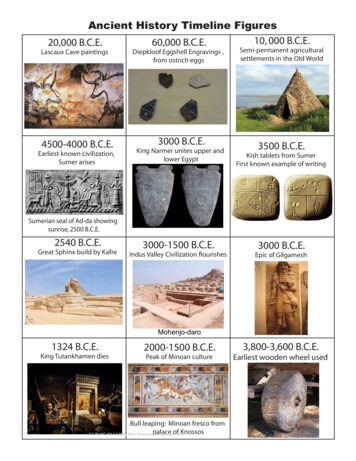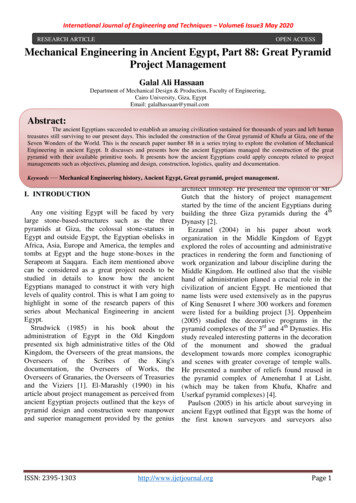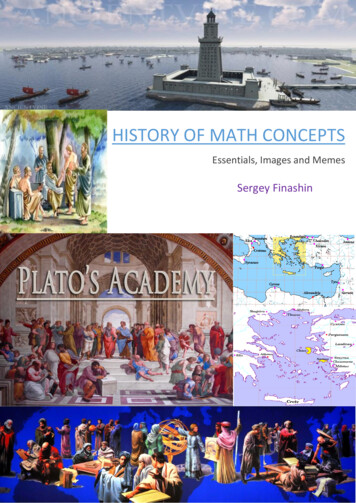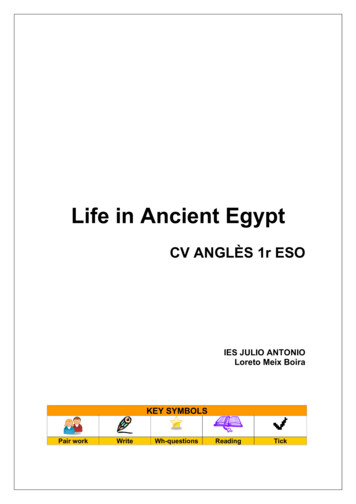
Transcription
Life in Ancient EgyptCV ANGLÈS 1r ESOIES JULIO ANTONIOLoreto Meix BoiraKEY SYMBOLSPair workWriteWh-questionsReadingTick
Ancient EgyptCLILContents1. The pharaoh32. Tutankhamen83. Cleopatra: the last Pharaoh134. The River Nile175. Economy226. Food237. Society298. Clothes and make up329. Death and mummification3610. Tombs and pyramids4411. Temples and beliefs4812. The Rosetta Stone52Final 4Loreto MeixSocial Science2
Ancient EgyptCLIL1 The PharaohLook at the Egypt map and at Tutankhamen’s tomb plan.a) Answer the questions below with the writing frame.2. Tutankhamen’s tomb plant.Questionsa) Where is Egypt?b) Where is the river Nile?c) How many doors are there inTutankhamen’s tomb?d) Where is the treasury?1. Egypt map.e) What is the burial chamber?d) What is the antechamber?Word bankPharaohfourNorthNileroomlastEgypt is in the of Africa.River is in Egypt.There are doors in Tutankhamen’s tomb.The treasure chamber is in the room.The burial chamber is in the room where the was buried.The antechamber is the before the treasury chamber.Loreto MeixSocial Science3
Ancient EgyptCLILA discoveryIn 1922 a British archaeologist, Howard Carter, was working in the Valley ofthe Kings in Egypt. One day he asked his workers to pull down a small hut.Carter noticed some steps under the hut and asked his men to clear them. Thesteps led to a stone wall and Carter told his men to cut through it. There was apassage behind the wall which led to yet another wall. They cut through this onewith care and suddenly came into a room full of household furniture andtreasure. Carter spent several months making a list of every article in the room.When he finished, he decided to cut through the opposite wall. He foundanother chamber full of valuable things. He saw two statues which looked likeguardians and Carter made a hole in the middle. There, he discovered threeboxes made of wood which fitted one inside the other. There was a fourth boxwhich was actually a coffin. Inside there was a mummy. Carter had discoveredTutankhamen’s tomb, an Egyptian pharaoh who lived 3000 years ago.Lord Carnavon, who financed the expedition, died several weeks after visitingTutankhamen’s tomb. Rumours started about a curse upon the men whoentered the tomb. The most powerful person in ancient Egypt was the pharaoh.The pharaoh was the political and religious leader of the Egyptian people. Heowned the land, made laws, collected taxes, and defended Egypt againstforeigners. He was a god on Earth. Read the text and check the words you don’t understand.GRAMMAR POINTPRESENT TO BEPAST TO BEI amyou arehe iswe areyou arethey areI wasyou werehe waswe wereyou werethey were Is the verb to be regular or irregular? Why? You can answer in Catalan. Do you know other irregular verbs in English? Write them down.Loreto MeixSocial Science4
Ancient EgyptCLIL EXERCISES1. These are regular verbs.AskdiediscoverlivelookAskedWrite the past:noticepullstartfinishfinance2. These are irregular verbs. Fill in the chart:(cut, found, spend, became, came, have and dLook at the pictures and answer the questions. An Egyptologist hasscrambled some words in the word bank.NOCIFFDPSYARIMIVRRELIENMMMUYa) The 1st picture is ab) The 2nd picturec) The 3rd pictureLoreto MeixSocial Science5
Ancient EgyptCLIL4.A journalist is interviewing Howard Carter. Write the words in thecorrect order to make questions.Where / in /you / were/ 1922/?Where were you in 1922?1 discoverer / who / the /Tutankhamen’s / was / tomb / of/?2 Tutankhamen’s / mummy / where / was /?3 was / who / father / Tutankhamen’s/?4 mother / who / was / Tutankhamen’s /?Now look at the text and answer the questions for Howard Carter.Where were you in 1922?I was at the Valley of the Kings in Egypt.12345. Write a short summary about Carter. Use the following words:archaeologist tomb kingmummypharaohEgyptCarter wasHe discoveredIn the tombThe pharaoh was6. Read the texts and check the words you don’t understand.More about the discoverersHoward Carter was aBritish Egyptologist. Heexcavated in Egypt, mainlythe King’s Valley. In 1922he became famousbecause he discoveredTutankhamen’s tomb. Heworked with LordCarnavon, his sponsor.Carter died in 1929.Loreto MeixRichard Bethell, Carter'spersonal secretary, andother persons related tothe discovery died. Thesefacts led to rumours aboutthe mummy’s curse. Thepress followed theincidents and lots of filmswere made.Lord Carnavon was thesponsor of the expeditionin Egypt. He died sixweeks after entering thetomb of Tutankhamen. Anew legend started: thePharaohs and their godshad laid a curse uponthose who dared to disturbtheir resting place.Social Science6
Ancient Egypt CLILWrite down 3 sentences about Carter, Bethell and Carnavon.Use the substitution table hardBethellwas1923AndXdiedin1939Carter’s secretary1929LordCarnavonCarter’s sponsora)b)c)7. Unscramble the letters to find 10 words connected with Tutankhamen.Loreto MeixSocial Science7
Ancient EgyptCLIL2 TutankhamenSentence makerLeft Tutankhamen mannequinand mask. AboveTutankhamen's tomb.Gold sandals.Gold throneBoat.All the objects belong to Tutankhamen’s tomb.Pair work. Write6 true sentences in your notebook.maskgoldismodel boatThe Pharaoh’sTutankhamen’smannequintombThe boy King’saremadeofstonewoodthronesandalsLoreto MeixSocial Science8
Ancient EgyptCLILRead the text. Check the words you don’t understand.Tutankhamen (ca. 1341-1323), the boy-king, reigned from 1334 to 1323 BC.He became world famous because of the rich and varied contents of his tomb.Tutankhamen inherited the throne when he was nine years old. He was the sonof Akhenaton and Nefertiti, his step-mother. During his reign he moved thecapital back to Thebes and restored the traditional religion, the cult of Amun,which his father had removed. He repaired temples and he constructed histomb near that of Amenophis III. He also continued construction at the temple ofKarnack. He had no heirs to continue his line.Tutankhamen's mummy revealed that the Pharaoh was only a teenager whenhe died. His death, with many claiming he was killed, still remains a mystery.Look carefully at this star.EXERCISES:1. What do these words mean? Link them with the word in the other column. Where?Where was the tomb/mummy discovered?HowardWhen was the mummy/tomb discovered?In EgyptCarter. When?. Who?Who discovered a tomb?A mummy. What?What did Carter find?In 1922Look, these two are more difficult. Why?. How?Loreto MeixWhy did Tutankhamen die? We don’t know.How did Tutankhamen die? We don’t know.Social Science9
Ancient EgyptCLIL2. Answer the following questions:Wh-questionsWho was Carter?Carter was . .What is a Pharaoh?A Pharaoh Where was Carter in 1922?In 1922 . . .Who was Tutankhamen?He .Where was Tutankhamen’s mummy?Tutankhamen’s mummy . Who was Tutankhamen’s father?Tutankhamen’s . Who was Tutankhamen’s mother?Tutankhamen’s . Who was Tutankhamen’s discoverer? . .was .Where was the Valley of the Kings?The Valley When did Tutankhamen live?He lived 3. Answer the following questions:About TutankhamenWho were Tutankhamen’s parents?How old was Tut when he inherited the throne?How old was Tutankhamen when he died?What temple did he finish?About Tutankhamen’s tomb (short answers)Was Tutankhamen’s tomb full of riches?When was his tomb discovered?What is the name of its discoverer?4.In pairs find the meaning of the following words. You can use thedictionary. Use your notebook and make a glossary:PharaohLoreto MeixkingqueenreigncountrySocial Science10
Ancient Egypt5.CLILWrite what millennium these dates belong to:19221341 BCNow write what century these dates belong to:19221341 BC6. Underline the oldest date.a) 1929 or 1922b) 1333BC or 1324BC7. Tutankhamen’s Crosswords1312324Across1. Chair for a sovereign or Pharaoh. 2. Temple partially built by Tutankhamen inEgypt. 3. The name of the man who discovered Tutankhamen’s tomb.4. Body of a person embalmed for burial.Down1. The name of the king of Egypt. 2. The place to bury people.3. The territory of a nation, a state.Loreto MeixSocial Science11
Ancient EgyptCLIL8. Draw a timeline about Tutankhamen’s period.1550New Kingdom1341Tutankhamen’s birth1334Tutankhamen becomes pharaoh1331Thebes becomes capital1323Tutankhamen’s death1069 End of the New KingdomRemember: add a reto MeixSocial Science12
Ancient EgyptCLIL3 Cleopatra: the last pharaoh in EgyptSorting cards Read the texts and match them with the historical figures below.AHe was a Roman general and triumvir. He took charge the Eastern Empirewhere he met Cleopatra. He fought against Octavian, the Roman Emperor,at the sea battle of Actium. Antony was defeated by Octavian and hecommitted suicide.BShe was the last Ptolemaic queen. She was restored to the throne byJulius Caesar, having been ousted by the guardians of her father PtolemyAuletes. After her brief relationship with Caesar she forged a longerpolitical and romantic alliance with Mark Antony, by whom she had threechildren. Their ambitions for the expansion of the Egyptian empire broughtthem into conflict with Rome, and she and Antony were defeated byOctavian at the battle of Actium in 31BC. She is supposed to havecommitted suicide by allowing herself to be bitten by an asp.CHe was a Roman general and a statesman. He established the FirstTriumvirate with Pompey and Crassus. He became consul in 59. As aresult of the civil war his power increased and became a dictator. He wasmurdered by Brutus.Cleopatra VII (59-30 BC)TextMark Anthony(82-30 BC, Alexandria)Julius Caesar (100-44 BC, Rome)TextTextSource: Encyclopaedia Britannica concise.britannica.com/ebc/art-76453Loreto MeixSocial Science13
Ancient EgyptCLILIn pairs order the texts below.1. She was a clever politician, with an ability to bring prosperity and peace to acountry that was ruined. By the end of her reign the country flourished. Sheknew how to read hieroglyphs and also spoke many foreign languages.Cleopatra met Julius Caesar in 48 BC and formed a political alliance with him.In 47 BC she had a child, called Caesarion. In 44 BC Caesar wasassassinated, and Cleopatra returned from Rome to Egypt. She murdered herbrother and co-regent, Ptolemy XIV, and appointed Caesarion to the throne.2. Cleopatra and Mark Antony abandoned his men and went to Egypt, wherethey lived for a year. Octavian followed Mark Antony to Egypt. Mark Antonytook his own life. On 12 August, 30 BC, 11 days after the death of her lover,Cleopatra chose also to commit suicide rather than live as a Roman captive.We still don’t know whether she died from a serpent's bite or ingested a dose ofpoison.3. In 41 BC Mark Antony sent for her to meet him in Tarsus, and it is believedthat they planned to create an Oriental (Eastern) Empire. They had threechildren - two sons and a daughter. On 2 September, in 31 BC, Anthony andCleopatra combined armies to take on those forces of Rome that were underthe control of Octavian - in the ancient world's last great sea battle, at Actium.4. Cleopatra VII (69-30 BC) was the 16th queen of the Ptolemaic dynasty,reigning over Egypt from 51 to 30 BC, during the Ptolemaic period. Shebecame co regent with her 10 year old brother Ptolemy XIII at the age of 17,and following his death (aged 14) in 47 BC during the civil war she married heryounger brother Ptolemy XIV, who was only 12 years old. In pairs order the texts.The first is text number.Loreto MeixSocial Science14
Ancient EgyptCLILEXERCISES1. Read the texts again. Are these sentences true (v) or false (x)?- Caesar was murdered by Octavian.- Mark Antony lived between 82 BC and 30 BC.- Cleopatra and Mark Anthony defeated Octavian in the battle of Actium.- Mark Anthony took charge of the Western Roman Empire.- Caesar became a dictator after a civil war.- Cleopatra was Octavian’s lover.- Cleopatra was a queen of the Ptolemaic dynasty in Egypt.- Cleopatra was born in 79 BC.- Mark Anthony and Cleopatra committed suicide.- Cleopatra spoke several languages.2.In pairs find the meaning of the following words. Take notes inyour notebook and make a glossary.empirearmydynastybattlesea battle3. Make a timeline with the following events about Cleopatra’s biography.Use milimetrical paper.Cleopatra’s birth 69 BCCleopatra’s death 30 BCCleopatra marries her brother in 47 BCalliance with Julius Caesar in 48 BCCaesar assassinated in 44 BCmeeting with Mark Anthony in 41 BCCaesarion’s birth in 47 BCsea battle in Actium in 31 BCLoreto MeixSocial Science15
Ancient EgyptCLIL4. Cleopatra’s crosswords.21412334567Across:1. The name of Cleopatra’s lover. 2. The name of Cleopatra’s son. 3. The line ofhereditary kings or Pharaohs. 4. The name of an important country in the northof Africa. 5. Salt water partially or wholly closed by land. 6. The name of a fightin military terms. 7. The name of a sea battle.Down:1. The name of an Egyptian queen (upside down). 2. The name of an Egyptiandynasty. 3. The name of an important Empire (upside down). 4. The name ofOctavian’s enemy (upside down).Loreto MeixSocial Science16
Ancient EgyptCLIL4. The River NileText comprehension and filling gapsA. The Nile is a river in eastern Africaand it runs from south to north. It is thelongest river in the world. It is 6,695Km long and it has an enormousdelta.B. The Nile was a busy river. It was fullof sailing ships which carried goodsand people from one town to another.C. In the past, Egyptians farmers useda shadoof, a pole with a bucket atone end used for raising water from ariver or canal.longestnorthThe Nile is aAfricariverlongdeltain easterntothe world. It is 6,695 Kmsouthand it runs from. It is theriver inand it has an enormous.goodsshipsThe Nile was awhich carriedBusyTownriver. It was full of sailingand people from oneto another.(c)Workshop(a) Shadoof (Ancient Egypt)Loreto Meix(b) Cadufol (Spain)Social Science17
Ancient EgyptCLILPICTURES A and B What was a shadoof for? Does anybody know what a cadufol or catufol is?Yes, INo, I(It is a tool for watering. There are cadufols near the River Ebro).PICTURE Ca) Is this a temple?b) Is this a workshop? (Where the craftsmen work)c) How many men are there?d) What are they doing?e) How are they dressed? Circle the true option.a) They wear shorts.River Nile sightsb) They wear skirts.c) They wear tunics.Ancient Egypt mapRiver NileRiver NileRiver Nile sunset 1River Nile painting Where is River Nile? Where is Egypt?Loreto MeixSocial Science18
Ancient EgyptCLILRead the text about River Nile and check the vocabulary.About 7,000 years ago the people of North Africa learnt to grow crops in the rich soilleft behind on the banks of the River Nile after it flooded each year. There they built therich and powerful country of Egypt. The Nile flooded every year from July to October –that is called the inundation. When the water receded, it left mud that was very usefulto grow crops. The Egyptians used the river for water and for fishing. Washing wasdone in the River Nile by men. The river was also an easy way to travel by boat.Ancient Egyptians had fields along the River Nile. The main towns and villages werenear the river. Most of their inhabitants were farmers. They lived in towns and invillages. In the towns also lived craftsmen, traders and other workers. The Egyptianstried to keep water from the River Nile which was very necessary to water their crops.They had a large network of irrigation canals that were filled with water from thereservoir. So farming was the main source of wealth in Ancient Egypt.EXERCICES1. Answer the following wh- questions What is the richest part of Egypt? The banks Why? Because River Nile Say three names of jobs in Ancient Egypt: What was the River used for? What is a reservoir? What are the crops?2. Mark on the compass the four cardinal points.SouthNorthEastWestLoreto MeixSocial Science19
Ancient EgyptCLIL3. Look up in a dictionary the meaning of these words and write it down inyour notebook.lakerivermountaincoastvalleyGRAMMAR POINTREGULAR VERBTO HAVEFill ed filledlive d livedplay ed playedtry ied triedI hadYou hadHe /she/it hadWe hadYou hadThey had4. Fill in the blanks with the verbs and answer the questions.waslivedfilledlearntIn ancient times EgyptianslearntThe River Nilehadleftto grow crops.an easy way to travel by boat.Egyptiansin towns and in villages along the River Nile.Ancient Egyptiansfields along the River Nile.Irrigation canals next to the river wereThe River Nile after inundationwith water from the reservoir.mud.a) Write all the verbs from the grid in present tense. learnt lived filled had was leftb) Which are regular verbs? Which are irregular?a) REGULAR:b) IRREGULAR5.Write a summary about River Nile.Use the following words: longsouth/northRiver Nile ismudgoodsIt runsAfter the inundation,The shipsLoreto MeixSocial Science20
Ancient Egypt6.CLILPair work. What was River Nile used for?For watering,7. Unscramble the words (jobs). Write them in your 8. Complete the sentences with the following words.rivergoodslongestnorth cropsyeardeltamud shadoofnorth/ southAncient Egypt was in the northof Africa.The Nile is ain Egypt.The Nile is theriver in the world.Ancient Egyptians grewin the soil near the River Nile.The River Nile flooded each.When the Nile flooded it left behind lots of.Ancient Egyptians carriedin the Nile.The River Nile has an enormousin the mouth.River Nile runs fromto.Awas a tool for watering the fields in Ancient Egypt.9. Write down the names on this map.WORD BANKRed SeaMediterranean SeaMemphisThebesAswan (Elephantine)LuxorNileAfricaEgyptArabian PeninsulaLoreto MeixSocial Science21
Ancient EgyptCLIL5 EconomyPair work. Link the pictures to the words:MaterialName in EnglishName in Catalancopper12granite3goldpapyrus sheets45wheat Can you say what these products were used for? Use the wordbank and the sentences below.sculpturesbronzeflourjewellerywritinga) Wheat was used to makeb) Copper was used toc) Granited) Golde) Papyrus sheets were Now ask your partner questions. Follow the example:What was used to make ?Loreto MeixSocial Science22
Ancient EgyptCLILAgriculture was the main economic activity. The harvests in Egyptwere very rich. The main crops of Ancient Egypt were wheat and barley butthey also grew fruits and flax used for the production of linens. There was nomoney system in Egypt. Products were bartered (exchanged) and workers werepaid in wheat or barley.Crafts were produced in small shops. Their goods included linen textiles, tools,weapons, perfumes and writing materials. Egypt also produced limestone andgranite.Trade was very important to Egypt, and goods were exported to and importedfrom countries around the Mediterranean Sea and the Red Sea. Silver, iron,cedar logs and horses were imported from the East. Ivory, copper, cattle,leopard skins were imported from the South. The main exports from Egyptwere gold and other minerals, wheat, barley and papyrus sheets.In pairs make questions about the text to ask another group.1.Write them in your notebook. Use the substitution table.QuestionsAnswers (help)growXDidproduceEgyptians/Did/Where didAncientEgyptians/importDiddidtheyWhere didexportLoreto ns?perfumes?writing material?ivory?copper?cattle?leopard skins?horses?silver?iron?cedar logs?gold?minerals?wheat?barley?papyrus sheets?in small shopsin workshopsfrom the Eastfrom the SouthabroadSocial Science23
Ancient EgyptCLIL2. Fill in the chart about the trade in Ancient Egypt:Egypt importedEgypt exported3. Look at the pictures and explain what these people are doing.ploughing (llaurant)WORDharvesting (collint)BANKscattering the seed (llavor)separating the grain from the strawfishinga) They areb) Theyc)d)e)Loreto MeixSocial Science24
Ancient EgyptCLIL6 FoodFood in Ancient EgyptEgypt is a very dry country. In the past apart from the River Nile they hadn’t anyother means to water the crops. They mainly grew wheat and barley. Egyptiansmade wheat into bread and into porridge. With barley they produced beer.Egyptians also ate meat and there were butcher’s shops, as today. At homethey had the meat in the courtyard. Egyptians didn’t eat pork because theythought pigs carried serious diseases. They ate beef, mutton and goose.For dessert, Egyptians ate dates. They also liked honey and fruits, like melonsand grapes.In ancient tombs archaeologists have found evidence of these kinds of foodwhich were displayed to eat in the next world.Odd one out. In every row there is an odd word.2. Beef3. Pork.1. Wheat.5. Honey.6. Dates.4. Potatoes.7. Goose.Loreto Meix8. Melons.9. Tomatoes.Social Science25
Ancient EgyptCLILIn pairs. Oral activity. What did people eat in Ancient Egypt? Use thesubstitution table and fill in the grid.a) Look at the substitution table andnotebook.Ancientdidn’tEgyptians eatwrite in pairs 6 true sentences in fporkatehoneyb) Now fill in the chart and classify the pictures. When you finish, check your answerswith the next table.Egyptian foodNot Egyptian foodXXXXXXXXX2. You are an Egyptian boy/girl. Write a report about the food you likemost. Use the words listed below.beefdates muttongoosebreadbeerhoneya) I like bread. I have bread at breakfast.a) I don’t like bread. I have meat at supper.Date treeLoreto MeixSocial Science26
Ancient Egypt3.CLILAsk your classmate questions. Look at these examples.Writedown sentences.Example A Do you like bread? “Yes, I do” or “No, I don’t”Example B Have you got dates? “Yes, I have” or “No, I haven’t”4. Answer the followingwh-questions:a)What is bread made of? Bread is made of flour / It is made of flour.What is beer made of?What is porridge made of?b)Where have archaeologists found food?Where did Egyptians keep the meat?What did Egyptians eat for dessert?What did Egyptians produce with barley?What did Egyptians produce with wheat?5. Fill in the following blanks with the verb to have.Egyptiansthe meat in the courtyard.Egyptiansbutcher’s shops.Egyptiansno other means to water apart from the River Nile.6. Why didn’t Egyptians eat pork?Egyptians didn’t eat pork because(Look the answer in the reading).Loreto MeixSocial Science27
Ancient Egypt7.CLILPair group: make and answer questions.1.Farming.2. Bread making.5. Farming1. Farming. Is the man3. Beer making6. Honey collecting4.Carrying a basquet.7. Hunting birds? Yes,2. Bread making. Is the man3. Making beer. Is the servant4. Carrying a basket. Is the servant5. Farming. Are the men6. Honey collecting. Is the man7. Hunting birds. Are theLoreto MeixSocial Science28
Ancient EgyptCLIL7 SocietyEgypt social pyramidPHARAOHUpper classMiddle STRADERS ANDCRAFTSMENFARMERSSERVANTSSLAVESLower classClassify the upper, the middle and the lower class.Upper classMiddle classLower classPharaoh Loreto MeixSocial Science29
Ancient EgyptCLILAt the top of the social pyramid were pharaohs, who were believed tobe gods. They had absolute power over their subjects. The pharaoh directedthe army and made laws.Below the pharaoh were powerful nobles and priests. Only nobles could holdgovernment posts; in these positions they profited from tributes paid to thepharaoh. Priests were responsible for pleasing the gods. Working with thenobles were scribes who kept government records. They could read and write.Soldiers fought in wars or controlled domestic uprisings. During long periods ofpeace, soldiers also supervised the peasants, farmers, and slaves who werebuilding pyramids and palaces.Skilled workers such as doctors and craftsmen made up the middle class.They made and sold jewellery, pottery, papyrus products, tools, and otheruseful things. Naturally, there were people needed to buy goods from artisansand traders. These were the merchants and storekeepers who sold thesegoods to the public.At the bottom of the social structure were farmers and slaves and servants.Farmers tended the fields and worked in the stones quarries and built pyramids.They paid taxes in form of grain. Slaves came from wars and had to work.EXERCISES1. Circle the odd one out. Then give a reason why it is the odd one out.a) A FarmersB SlavesC PharaohD Servantsc) A PriestsB OfficialsC NoblesD Merchantsd) A OfficialsB TradersC CraftsmenD Merchants2. Ancient Egypt Acrostic PoemAn acrostic poem is one where you choose a word or name and use each letterin the name as the beginning of a word or line that tells something about thatperson or topic.Loreto MeixSocial Science30
Ancient EgyptCLILExample: An acrostic poem using the word "friend."Frank my brotherReally loves me. He bought me anIce-creamEntirely roundNeverDid he give me such a nice present!Write an Acrostic Poem using the word below.SOCIAL3. Social Pyramid Word Search OHSLAVESPRIESTLoreto NTSMERCHANTSSOLDIERSSocial Science31
Ancient EgyptCLIL8 Clothes and make upFill in a chart1. Sandals.4. Linen tunic.2. Necklace.5. Linen skirt.1. In pairs look at the pictures. Then tickWho wore this?sandalsnecklacewigslinen tunicskirtmake upMEN3.Wig.6. Make up.the right columns.WOMEN2. Read the text written by Herodotus and answer the question below.They [Egyptians] are very careful to wear newly-washed linen all the time. They circumcisetheir children for the sake of cleanliness; they would rather be clean than better looking. Herodotus was a Greek historian. Were Egyptians clean or dirty?Loreto MeixSocial Science32
Ancient EgyptCLILRead the text and check the vocabulary.Egypt is a very hot country, so Egyptians didn’t wear very much. AncientEgyptian, men and women, wore white tunics made of linen. White colourreflects the sunlight. The most important people, like officials or scribes woreseveral pieces of very thin cloth, which were more expensive. They did notcover their heads with any piece of cloth. Most of them went barefoot but somewore sandals made of leather or papyrus.–outdoor occupations- usually used apiece of cloth wrapped round their waists and legs. Men and women wore blueand green eye shadow and black kohl eyeliner. This make-up was made fromplants and minerals. Men wore their hair short or shaven. They had no beardsor moustaches. But women wore long hair down to the shoulders. Some menand women wore wigs made from human hair or plants. Only rich people worewigs made of human hair. If they were very rich, both men and women woregold jewellery.EXERCISES1.Write true sentences. Write them in your notebook.Men & womenMenWomenRich peoplePoor peoplewore/(Fishermen andfarmers)didn’twear/wentlonghairplants andblackkohl pyrusleathergoldhuman hairlinenmade ofshaventhintunicsexpensivewigsgreenbarefooteye shadowXlinenskirtsE.g. Rich people wore thin tunics made of linen.Now you can continue. You don’t need to use all the words in a column.Loreto MeixSocial Science33
Ancient Egypt2.CLILIn pairs look up in a dictionary the meaning of these words andwrite it down in your notebook.goldleatherstonewoodmineralsEx. Gold is a yellow precious metal.3. Answer the following questions. Wear present / wore past tenseWho wore jewellery? Rich men and women wore jewellery.Who wore a cloth round the waist?Who wore thin tunics?Who wore make-up round their eyes?Who wore ordinary tunics?4. Complete the following sentences as in the example.plants and mineralsleatherlinengoldhair or plantsKohl eyeliner was made from plants and minerals.Sandals were made ofTunics were madeJewellery was.Wigs were made from.5. Put the words in the correct order to make sentences.Ex. did cover Egyptians their not heads any cloth piece with of.Egyptians did not cover their heads with any piece of cloth.Egyptian linen and white of Ancient women men tunics made woresandals barefoot most Egyptians went of but some woreshaven their wore short men hair orcolour sunlight the white reflectsLoreto MeixSocial Science34
Ancient EgyptCLILGRAMMAR POINTVERB TO DOPAST DIDNEGATIVE Did not didn’tEgyptians didn’t cover their heads.Didn’t Egyptian cover their heads?Egyptians didn’t wear very much.Did Egyptian wear very much?6. Match the opposites of the following adjectives:longthick coldcheappoor wetTHINEXPENSIVEHOTSHORTRICHDRY7. Write the following body parts.WORD BANKLoreto MeixManSocial Science35
Ancient EgyptCLIL9 Death and Mummificationa) Can you match the words from A column with B?Column AAMummificationBNatronCKaA, B,CColumn BThe spiritual part of a humanbeing or god (soul), whichsurvived after death in AncientEgypt.To treat a dead body to keep it.Ancient Egyptians used natronand oils to preserve them.Mineral form of hydrated saltsfound in dried lake beds, usedfor embalming.b) Multiple choice What was mummification for? Highlight the correct answer.a) For the after life. Egyptians believed in a second life.b) Because they liked it.c) Because they wanted to preserve the body. What was natron for?a) For cooking. It is very useful.b) Mineral salts, very useful for mummification.c) To throw it into the water. What was ka?a) Ka was a fly.b) Ka was the spiritual part of the body.c) Ka was the soul of the Pharaoh.c) Do you believe in afterlife?(You can answer in Catalan)Loreto MeixSocial Science36
Ancient EgyptCLILWhat is mummification?Mummification was done to preserve the body because the soul and the kameet and li
3 Cleopatra: the last pharaoh in Egypt Sorting cards Read the texts and match them with the historical figures below. A He was a Roman general and triumvir. He took charge the Eastern Empire where he met Cleopatra. He fought against Octavian, the Roman Emperor, at the sea battle of Act
